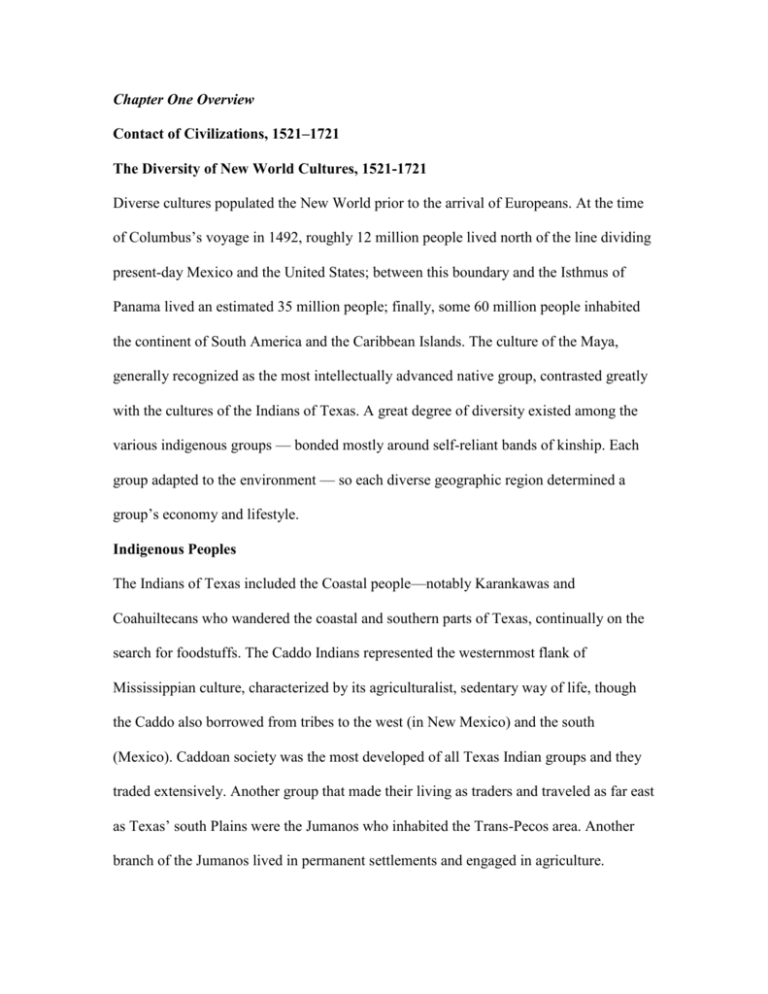Chapter One Overview Contact of Civilizations, 1521–1721 The
advertisement

Chapter One Overview Contact of Civilizations, 1521–1721 The Diversity of New World Cultures, 1521-1721 Diverse cultures populated the New World prior to the arrival of Europeans. At the time of Columbus’s voyage in 1492, roughly 12 million people lived north of the line dividing present-day Mexico and the United States; between this boundary and the Isthmus of Panama lived an estimated 35 million people; finally, some 60 million people inhabited the continent of South America and the Caribbean Islands. The culture of the Maya, generally recognized as the most intellectually advanced native group, contrasted greatly with the cultures of the Indians of Texas. A great degree of diversity existed among the various indigenous groups — bonded mostly around self-reliant bands of kinship. Each group adapted to the environment — so each diverse geographic region determined a group’s economy and lifestyle. Indigenous Peoples The Indians of Texas included the Coastal people—notably Karankawas and Coahuiltecans who wandered the coastal and southern parts of Texas, continually on the search for foodstuffs. The Caddo Indians represented the westernmost flank of Mississippian culture, characterized by its agriculturalist, sedentary way of life, though the Caddo also borrowed from tribes to the west (in New Mexico) and the south (Mexico). Caddoan society was the most developed of all Texas Indian groups and they traded extensively. Another group that made their living as traders and traveled as far east as Texas’ south Plains were the Jumanos who inhabited the Trans-Pecos area. Another branch of the Jumanos lived in permanent settlements and engaged in agriculture. Spain’s initial and strongest competition in the colonization of Texas came not from rival European empires but from indigenous nations of the region. Although the more militant Plains groups such as the Apaches and Comanches did not enter Texas until the seventeenth century, the Comanches emerged as the dominant force in Texas because of their high mobility (with acquisition of the horse) and equestrian skills (having acquired horses in the seventeenth century). With a lack of a pan-tribal political structure, the Comanches created intense turmoil even among their Plains neighbors, especially the Apaches. The First Europeans Various groups—the Greeks, Romans, Visigoths, and Moors—ruled the Iberian Peninsula at various times during the centuries prior to the reconquista. As a result, the Spanish brought influences from all of these cultures to the New World. The early Spanish explorers sought their fortunes in the New World and Texas and brought with them the trappings of Spanish civilization, much of it a legacy of Spain’s own reconquista experience. The Spaniards used the rancho, the mission, the villa, and the presidio to settle the American Southwest. Other manifestations of the reconquista that eventually impacted the New World included the raising of sheep and cattle in the reconquered areas of southern Castile. Cattle raising on New Spain’s far northern frontera (frontier) led to the development of the vaquero with his distinctive dress, equipment and skills. While Spain employed modified forms of traditional institutions, the Dutch, English and French also sought to establish footholds in the region east of the Mississippi River. Although its success was limited, Spain introduced Christianity to the Indian groups and agriculture to native peoples in South and West Texas. Preventing French encroachment into New Spain remained the crown’s primary goal for Texas. Incorporation Incorporation, the process of transplanting the Spanish civilization in the New World, ensured defense of the northernmost frontier from foreign threats by linking this region to social and political systems in New Spain’s interior, assimilating or annihilating the indigenous population at the same time. Ties to the Spanish empire were established and maintained through the presidio, the mission, the rancho and the villa. Chapter One Learning Outcomes Upon completion of studying this chapter, you will be able to: comprehend the New World setting and Old World historical factors that shaped the era of Spanish exploration and settlement, appreciate the indigenous presence and the cultural exchanges taking place, understand the Europeanization process, including colonizing baggage and institutionalization, comprehend the significance of incorporation. Chapter One Key Words and Terms Pre-contact Era • Tenochtitlan • Coahuiltecans • Caddo • Jumano Spanish Era 1521-1821 • Alvar Núñez Cabeza de Vaca • Jose de Escandon • Alonso de León • Francisco Coronado • Gran Quivira • Louis Juchereau de St. Denis • Father Francisco Hidalgo • Captain Domingo Ramón Spanish terms • reconquista • conquistadores • rancheros • vaqueros Chapter One Links Columbus’ Letter to the King and Queen of Spain — Columbus explains his proposal for Spanish colonization and commerce in the Caribbean. Southwestern Writers Collection: Cabeza de Vaca — Contains numerous sources on Cabeza de Vaca, including film excerpts and an English translation of La relación. The Journey of Coronado — Outstanding PBS website, with detailed descriptions (primary source), resources, lesson plans and quiz The Five Spanish Missions of San Antonio de Bexar — A brief overview The Alamo — Site of the Daughters of the Republic of Texas. The DRT serves as the custodian of the Alamo. Old Spanish Missions of San Antonio — Information on the four old Spanish missions operated by the National Park Service in collaboration with the Archdiocese of San Antonio. Spanish Missionary Activity in Texas — Houston Institute of Culture. An overview of Spanish missionary activity in Texas from 1682 to 1793, including valuable links. Nacogdoches, the “oldest town in Texas” Ranching in Spanish Texas — Explores Spanish ranching traditions The Caddo Indians — This article from the Handbook of Texas Online introduces the Caddo Indians.









